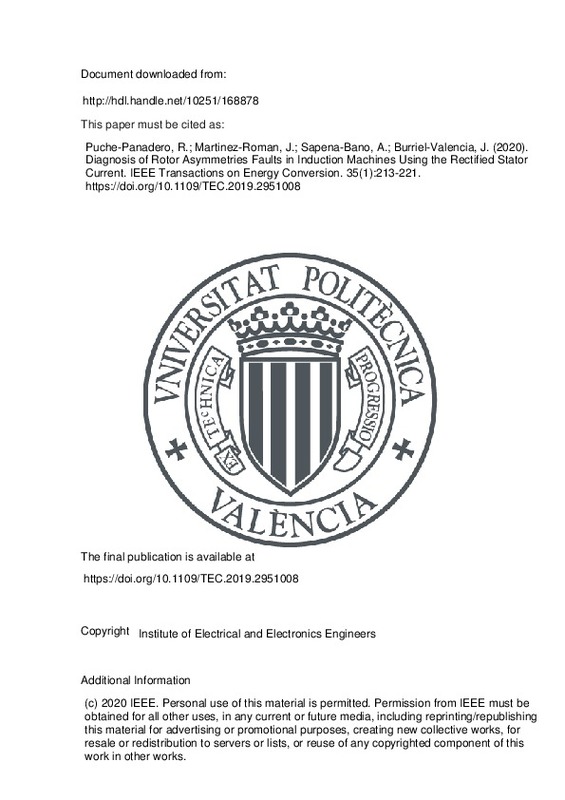JavaScript is disabled for your browser. Some features of this site may not work without it.
Buscar en RiuNet
Listar
Mi cuenta
Estadísticas
Ayuda RiuNet
Admin. UPV
Diagnosis of Rotor Asymmetries Faults in Induction Machines Using the Rectified Stator Current
Mostrar el registro sencillo del ítem
Ficheros en el ítem
| dc.contributor.author | Puche-Panadero, Rubén
|
es_ES |
| dc.contributor.author | Martinez-Roman, Javier
|
es_ES |
| dc.contributor.author | Sapena-Bano, Angel
|
es_ES |
| dc.contributor.author | Burriel-Valencia, Jordi
|
es_ES |
| dc.date.accessioned | 2021-07-07T03:31:08Z | |
| dc.date.available | 2021-07-07T03:31:08Z | |
| dc.date.issued | 2020-03 | es_ES |
| dc.identifier.issn | 0885-8969 | es_ES |
| dc.identifier.uri | http://hdl.handle.net/10251/168878 | |
| dc.description | (c) 2020 IEEE. Personal use of this material is permitted. Permission from IEEE must be obtained for all other uses, in any current or future media, including reprinting/republishing this material for advertising or promotional purposes, creating new collective works, for resale or redistribution to servers or lists, or reuse of any copyrighted component of this work in other works. | es_ES |
| dc.description.abstract | [EN] Fault diagnosis of induction motors through the analysis of the stator current is increasingly being used in maintenance systems, because it is non-invasive and has low requirements of hardware and software. Nevertheless, its industrial application faces some practical limitations. In particular, the detection of fault harmonics that are very close to the fundamental component is challenging, as in large induction motors working at very low slip, because the leakage of the fundamental can hide the fault components until the damage is severe. Several methods have been proposed to alleviate this problem, although all of them increase noticeably the complexity of the diagnostic system. In this paper, a novel method is proposed, based on the analysis of the rectified motor current. It is shown that its spectrum contains the same fault harmonics as the spectrum of the original current signal, but with a much lower frequency, and free from the fundamental component leakage. Besides, the proposed method is very easy to implement, either by software, using the absolute value of the current samples, or by hardware, using a simple rectifier. The proposed approach is presented theoretically and validated experimentally with the detection of a broken bars fault of a large induction motor. | es_ES |
| dc.description.sponsorship | This work was supported in part by the Spanish "Ministerio de Ciencia, Innovacion yUniversidades (MCIU)," in part by the "Agencia Estatal de Investigacion (AEI)," and in part by the "Fondo Europeo de Desarrollo Regional (FEDER)" in the framework of the "Proyectos I+D+i -Retos Investigacion 2018," under Project RTI2018-102175-B-I00 (MCIU/AEI/FEDER, UE). | es_ES |
| dc.language | Inglés | es_ES |
| dc.publisher | Institute of Electrical and Electronics Engineers | es_ES |
| dc.relation.ispartof | IEEE Transactions on Energy Conversion | es_ES |
| dc.rights | Reserva de todos los derechos | es_ES |
| dc.subject | Induction machines | es_ES |
| dc.subject | Fault diagnosis | es_ES |
| dc.subject | Fast Fourier transform | es_ES |
| dc.subject | Spectral leakage | es_ES |
| dc.subject | MCSA | es_ES |
| dc.subject.classification | INGENIERIA ELECTRICA | es_ES |
| dc.title | Diagnosis of Rotor Asymmetries Faults in Induction Machines Using the Rectified Stator Current | es_ES |
| dc.type | Artículo | es_ES |
| dc.identifier.doi | 10.1109/TEC.2019.2951008 | es_ES |
| dc.relation.projectID | info:eu-repo/grantAgreement/AEI/Plan Estatal de Investigación Científica y Técnica y de Innovación 2017-2020/RTI2018-102175-B-I00/ES/DISEÑO DE MODELOS AVANZADOS DE SIMULACION DE AEROGENERADORES PARA EL DESARROLLO Y PUESTA A PUNTO DE SISTEMAS DE DIAGNOSTICO DE AVERIAS "ON-LINE"./ | es_ES |
| dc.rights.accessRights | Abierto | es_ES |
| dc.contributor.affiliation | Universitat Politècnica de València. Departamento de Ingeniería Eléctrica - Departament d'Enginyeria Elèctrica | es_ES |
| dc.description.bibliographicCitation | Puche-Panadero, R.; Martinez-Roman, J.; Sapena-Bano, A.; Burriel-Valencia, J. (2020). Diagnosis of Rotor Asymmetries Faults in Induction Machines Using the Rectified Stator Current. IEEE Transactions on Energy Conversion. 35(1):213-221. https://doi.org/10.1109/TEC.2019.2951008 | es_ES |
| dc.description.accrualMethod | S | es_ES |
| dc.relation.publisherversion | https://doi.org/10.1109/TEC.2019.2951008 | es_ES |
| dc.description.upvformatpinicio | 213 | es_ES |
| dc.description.upvformatpfin | 221 | es_ES |
| dc.type.version | info:eu-repo/semantics/publishedVersion | es_ES |
| dc.description.volume | 35 | es_ES |
| dc.description.issue | 1 | es_ES |
| dc.relation.pasarela | S\400258 | es_ES |
| dc.contributor.funder | Agencia Estatal de Investigación | es_ES |
| dc.contributor.funder | European Regional Development Fund | es_ES |







![[Cerrado]](/themes/UPV/images/candado.png)

